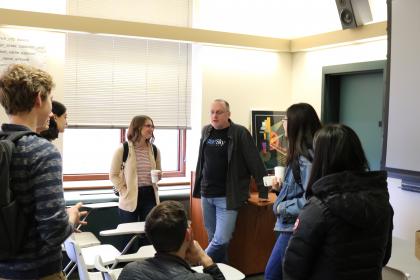An Animated Talk on Visual Effects For Movies

From the tools used to make some of the biggest movies of the last few years to the sheer amount of effort that goes into getting water to look just right, visual effects specialist Hank Driskill gave students this week a detailed overview of the work animated film production.
 During a visit to the Yale campus, Driskill spoke to the students of CPSC 478 (Computer Graphics), taught by Holly Rushmeier, professor of computer science. Driskill has worked in the feature film industry for over 20 years, most of the time at Disney, in the area of animated film production. His recent screen credits include "Moana" and "Big Hero 6."
During a visit to the Yale campus, Driskill spoke to the students of CPSC 478 (Computer Graphics), taught by Holly Rushmeier, professor of computer science. Driskill has worked in the feature film industry for over 20 years, most of the time at Disney, in the area of animated film production. His recent screen credits include "Moana" and "Big Hero 6."
While he always liked to draw, Driskill said he thought wasn’t good enough to make a living out of it. He was good at math and science but didn’t have a passion for it. Then “Tron” came out and the visual effects - state-of-the-art for 1982 - were a revelation.
“They were using math to make art - I said ‘That’s what I want to do,’” he told the class.
Now the chief technology officer for Blue Sky Studios, Driskill talked about his career and answered questions about the field of visual effects.
Although he did groundbreaking work on live action films such as “Avatar” and “Reign of Fire” (which boasted the first computer generated fire), Driskill greatly prefers working on animated films. “In live-action films, we’re always trying to make it photorealistic, which is a clearly defined goal. In animation, you’re crafting an entire world.”
He also discussed some of the methods for putting together animated films, such as the use of “scratch dialogue.” That’s where, long before the well-paid actors come in to voice their roles, the dialogue is read by folks in the studio building - secretaries, for instance, or maybe someone in payroll. Later, everyone gathers in the screening room to see how the dialogue and action work together.
No matter how good his visual effects may be for a live action film, Driskill said, the overall quality of the movie is out of his control. In animation, though, the creative process is much more collaborative. “The thing rests on everyone collectively,” he said.
Driskill’s been part of several breakthroughs. Among them were developing the very intricate bar scene in “Moana;” finding a new way to render particles in “Apollo 13” - far more detailed than any previous movie; and his work on the water in James Cameron’s “Titanic.” Cameron also asked Driskill to work on the visual effects for “Avatar” more than a decade before it was produced.
“I remember reading the script and I could almost physically feel my brain split in half,” he said. “One half of me was saying ‘My God, how do we do this?’ It had characters interacting with water and all kinds of things. This was 1996 - nobody was doing anything like that yet. But then half of me was like, ‘We have to do this!’"
For very film since, he said, he’s aimed for that feeling of “equal parts of terrified and exhilarated - otherwise you’re not aiming high enough.”

